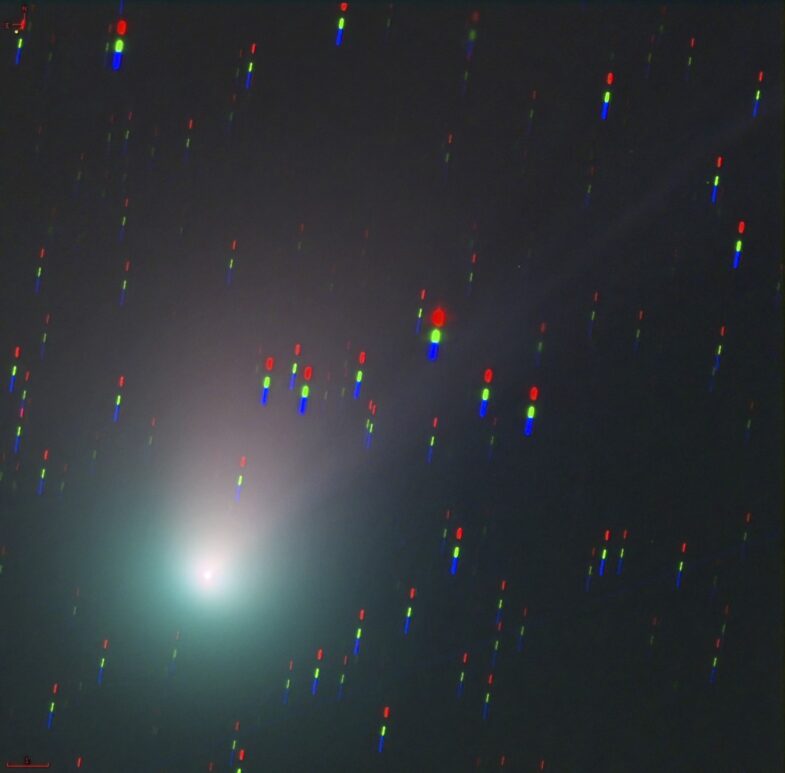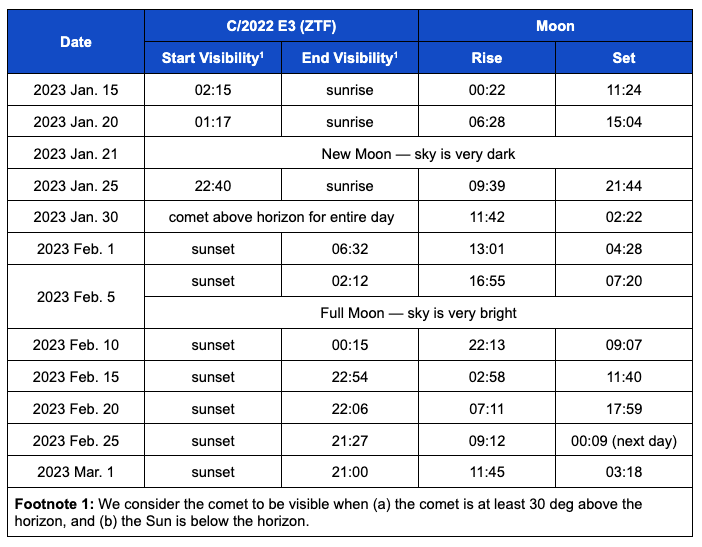
Viewing Comet C/2022 E3 (ZTF) from Massachusetts
Get ready: comet C/2022 E3 (ZTF) will become easily viewable with binoculars over the next few weeks!
The comet is expected to be brightest around February 1, 2023. Current brightness data, as well as predictions for the future, are available here.
Current predictions indicate that C/2022 E3 (ZTF) will be easily visible when using binoculars, but will not be observable with the naked eye. However, many previous comets have brightened unexpectedly, and this might also happen to this comet. Avid observers should therefore monitor how the comet’s brightness develops.
An excellent observing guide to comet C/2022 E3 (ZTF) has been compiled by the Haus der Astronomie (it’s in English!). Below, we complement that guide with rise and set times for comet C/2022 E3 (ZTF) and the Moon.
The period about January 20–February 1 will be best for viewing of the comet, with best conditions prevailing from about January 25–February 1. During that time, the comet is expected to be particularly bright, while the Moon is relatively dark and below the horizon for a large fraction of the night. The comet will be located approximately between the constellations of the Little Dipper and the Large Dipper, as shown in the sky chart from the Haus der Astronomie (in English). The following factors should be taken into consideration when viewing the comet:
- It is best to leave the city lights behind. Locations with no big towns or cities to their North will be ideal.
- Consult the table below to see when the comet is visible. Ideally pick a time after the Moon has set.
- Do not expect to see the comet with the naked eye. Use the star chart linked above to get an idea where the comet is located. Then search the area with a binocular. Any basic binocular should do around February 1; high-powered optics or telescopes will not be needed (but they can, of course, be used too!).
- The comet will appear as a roundish nebulosity (cloud-like blob) when seen with binoculars. Finer structure in the comet’s head might become visible after some adaption of the eye. The comet will be too faint to sense color variations in the object.
You should try to observe even if the conditions are not ideal! Some comets can even be observed from the city. The best conditions are always those that work for you!

Comet naming: not as crazy as it seems
Comets are identified via a numbering scheme. This became necessary because modern telescopes keep discovering comets at an astonishing rate.
In the case of C/2022 E3, the label “C” indicates that the comet has a period of more than 200 years. This comet, in fact, takes 50,000 years to complete one orbit in the solar system!
The code “2022” indicates the year of the discovery. The identifier “E” means that this is a comet detected in the 5th half-month period of the year, while the integer “3” indicates that this is the 3rd comet discovered in that interval. So, in combination, “E3” identifies this comet to be the 3rd discovered in the period March 1–15, 2022.
The label “ZTF,” given in a bracket, states the name of the discoverer. Here “ZTF” stands for “Zwicky Transient Facility,” an experiment in Southern California searching for changes in the night sky, such as the appearance of comets.